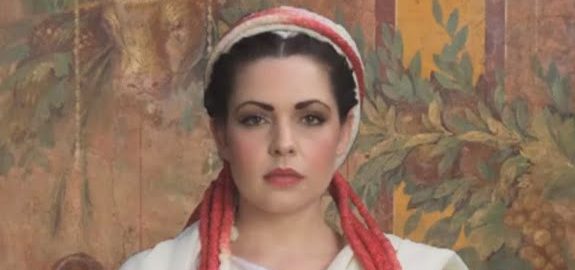A contemporary woman with a vestal hairstyle and headdress. Vestal was the priestess of the Roman goddess of the hearth, Vesta. Girls aged 6-10 were selected for service, only those from patrician families whose parents were alive. They promised under oath celibacy and virginity.
By becoming priestesses, the Vestals indirectly avoided many of the social restrictions that usually affected Roman women. Their braided hairstyles (seni crines) symbolized purity and were the oldest hairstyles in the Roman world.
Archaeologist Janet Stephens made attempts to reconstruct the hairstyle. As he recalls, the seni crines hairstyle was still a challenge, as it covered most of the head’s surface, and on sculptures and other works of art, details were often obscured. As he mentions, problems were natural in this situation, because the ceremonial headgear of the Vestals consisted of many layers. A rectangular veil with a red trim (suffibulum) was fixed on the chest with brooches (fibula). There was an infula band under the scarf. At the front was a vitta, consisting of ribbons and strings holding the hairstyle together.
During the symposium show, only period tools were used: a comb, hairpins, string (vitta) and hairpins. She helped herself with the arrangement of Stephens with water. The hair at the top of the head was divided into 3 double sections (holding pins came in handy here). She started braiding the braids from the middle segments. Then came the hair from the back of the head. The archaeologist of hairstyles also cross-linked the hair from under the occipital plaits and from the back panel. Then she wrapped the strands of the front “quarters” – the hairline – around the rope and then tied the string around the nape of her neck using a straight knot. At the end she made the 7th braid – she used the hair hanging under the left ear after braiding around the vitta and after reaching the desired length she pulled the braid by the knot. There she joined the hair hanging from the right side of the rope. She made 3 strands again and weave them along the entire length.
Loose pigtails were hanging from the head at this stage. For the hairstyle to become a coherent whole, Stephens had to lift and hold the 7th braid and then swing a pair of braids at the back of her head. Later, she connected them all at the top of her head with a straight knot and secured the knot with a pin. She wrapped the seventh braid around her finger and tucked it under the dense layer on the back of her head.
The American woman put on a headband (infula) and connected it to the suffibulum with a clip. She wrapped the edge of the fabric at the face and attached the horns with a brooch to the tunic.
Stephens took about 40 minutes to work on the hairstyle, but as the archaeologist of hairstyles points out, the Vestals probably helped the slaves. If several people were involved in braiding the braids, seni crines would have been created in less than a quarter of an hour.
Video showing the process of creating a seni crines hairstyle






